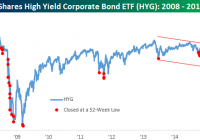ETFReplay.com Portfolio September Update
The ETFReplay.com Portfolio holdings have been updated for September 2015. I previously detailed here and here how an investor can use ETFReplay.com to screen for best-performing ETFs based on momentum and volatility. The portfolio begins with a static basket of 14 ETFs. These 14 ETFs are ranked by 6-month total returns (weighted 40%), 3-month total returns (weighted 30%), and 3-month price volatility (weighted 30%). The top 4 are purchased at the beginning of each month. When a holding drops out of the top 5 ETFs, it will be sold and replaced with the next highest ranked ETF. The 14 ETFs are listed below: Symbol Name RWX SPDR Dow Jones International Real Estate ETF PCY PowerShares Emerging Markets Soverign Bond Portfolio ETF WIP SPDR DB International Government Inflation-Protected Bond ETF EFA iShares MSCI EAFE ETF HYG iShares iBoxx $ High-Yield Corporate Bond ETF EEM iShares MSCI Emerging Markets ETF LQD iShares iBoxx $ Investment Grade Corporate Bond ETF VNQ Vanguard REIT Index ETF TIP iShares TIPS Bond ETF VTI Vanguard Total Stock Market ETF DBC PowerShares DB Commodity Index Tracking ETF GLD SPDR Gold Trust ETF TLT iShares 20+ Year Treasury Bond ETF SHY iShares 1-3 Year Treasury Bond ETF In addition, ETFs must be ranked above the cash-like ETF (NYSEARCA: SHY ) in order to be included in the portfolio, similar to the absolute momentum strategy I profiled here . This modification could help reduce drawdowns during periods of high volatility and/or negative market conditions (see 2008-2009), but it could also reduce total returns by allocating to cash in lieu of an asset class. The cash filter is in effect this month, the same as the previous two months. SHY is the highest-rated ETF in the 6/3/3 system. Therefore, it will continue to be the sole holding in the portfolio. The top 5 ranked ETFs based on the 6/3/3 system as of 8/31/15 are below: 6-mo/3-mo/3-mo SHY Barclays Low Duration Treasury (2-year) VTI Vanguard Total U.S. Stock Market HYG iShares iBoxx High-Yield Corp Bond PCY PowerShares Emerging Mkts Bond (7-9 year) TIP iShares Barclays TIPS In 2014, I introduced a pure momentum system, which ranks the same basket of 14 ETFs based solely on 6-month price momentum. There is no cash filter in the pure momentum system, volatility ranking, or requirement to limit turnover – the top 4 ETFs based on price momentum are purchased each month. The portfolio and rankings are posted on the same spreadsheet as the 6/3/3 strategy. The top four 6-month momentum ETFs are below: 6-month Momentum SHY Barclays Low Duration Treasury (2-year) PCY PowerShares Emerging Mkts Bond (7-9 year) TIP iShares Barclays TIPS TLT iShares Barclays Long-Term Trsry VTI, a holding for just one month, will be sold for a loss of 6.09%. HYG, a holding since June 30th, will be sold for a loss of 2.88%. EFA, a holding since April 30th, will be sold for a loss of 9.83%. They will be replaced by TIP, PCY, and TLT. The updated holdings for each portfolio are below. 6/3/3 strategy: Position Avg. Purchase Price Purchase Date Percentage Gain/Loss Excluding Dividends SHY 84.86 5/29/2015 & 6/30/15 -0.09% Pure Momentum strategy: Position Purchase Price Purchase Date Percentage Gain/Loss Excluding Dividends PCY 27.65 8/31/2015 0.00% SHY 84.86 7/31/2015 -0.09% TIP 111.58 8/31/2015 0.00% TLT 121.42 8/31/2015 0.00% Disclosure: None.
